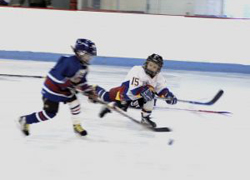Winter brings many outdoor activities for children to enjoy with the snow and on the ice. Unfortunately, sledding, skiing, snowboarding, and skating result in thousands of injuries to children each year. The good news is that many of these injuries can be prevented.
Old man winter brings many outdoor activities for children to enjoy with the snow and on the ice. Yet, Safe Kids Northern NJ cautions that sledding, skiing, snowboarding, and skating result in thousands of injuries to children each year. For field/ice hockey alone, an estimated 22,346 children ages 14 and under were injured in 2009 according to the Consumer Product Safety Commission. The good news is that many of these injuries can be prevented. Parents can help keep their children injury free by taking a few simple precautions.
Safe Kids USA Reminds Parents to Keep Kids Safe On and Off the Slopes
“It begins with providing the proper clothing, safety gear and sun screen and by ensuring their child stays hydrated,” said KJ Feury Safe Kids Northern NJ Coalition Coordinator. “In addition, providing children a snowboarding or skiing lesson before they head to the slopes will provide them with the necessary skills to not only reduce their frustrations but also their risk of injury. Finally, parents need to have their children come inside periodically to warm up and prevent hypothermia or frostbite.”
Approximately 2 out of 5 traumatic brain injuries among children are associated with participation in sports and recreational activities. Studies indicate that wearing a helmet can reduce the risk of impact forces to the brain. Safe Kids Northern NJ recommends children always wear helmets when sledding, skiing, snowboarding, or playing ice hockey.
Here’s additional tips for parents” to keep their children safe this winter.
PROPER CLOTHING
- Dress your child in layers - warm close-fitting clothes; a hat; boots; gloves or mittens that are preferably waterproof, and a scarf, or facemask.
- Make sure your child’s scarf is tucked in so that it doesn’t get entangled in lifts, ski poles, or other equipment.
SUN PROTECTION
- Cover your child’s exposed skin with sunscreen to protect their skin from the sunlight, which reflects off the snow.
SAFETY GEAR
- Ensure your child always wears the sport-specific, properly fitted safety gear. For example, knee pads are just as important for snowboarding as they are for field/ice hockey.
- Helmets should always be worn by children when they ski, sled, snowboard, snowmobile, and play ice hockey. Make sure your child wears a helmet that is appropriate for the particular activity or sport because there are different helmets for different activities.
- Keep the helmet well-maintained, and it should always be properly fitted to your child’s head. Replace the helmet as soon as it has been hit hard or involved in a crash or impact. Even though there may not be any visible damage to the helmet, it will not effectively absorb the impact of a future crash or may have a hair line crack invisible to the human eye.
STAYING HYDRATED
- Encourage your child to drink water before, during and after play in order to stay fully hydrated. Here’s some general guidelines to prevent dehydration
Staying Hydrated: Before an activity
- Drink 12 ounces of fluid 30 minutes
Staying Hydrated: During an activity
- Children under 90 pounds: Drink 5 ounces every 20 minutes
- Children over 90 pounds: Drink 9 ounces every 20 minutes
Staying Hydrated: After an activity
- Drink every 20 minutes during the first hour after the activity to make up for fluid loss.
